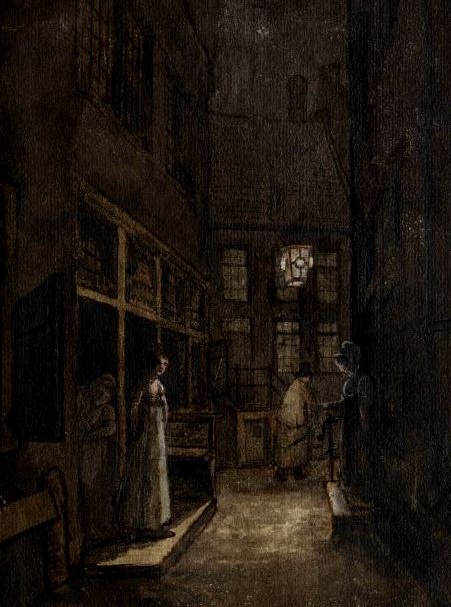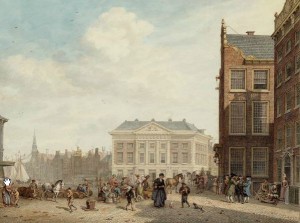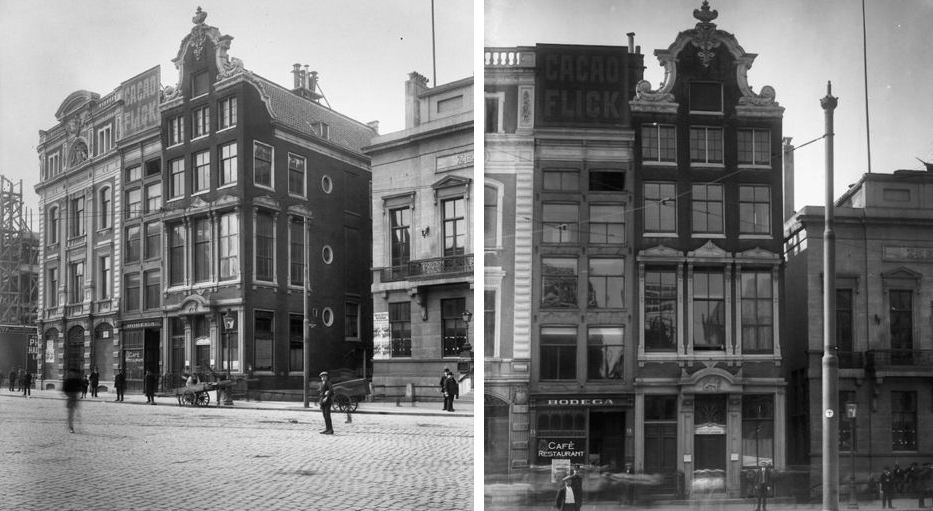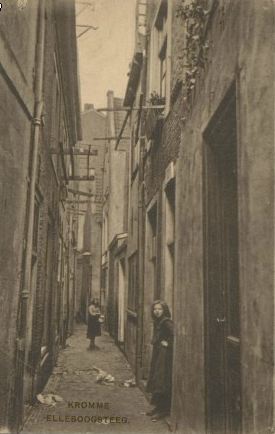Jean Isedore Allis and Antje Klaasen lived with their children on a long street in Amsterdam called “Kromme Elleboogsteeg” (which translates into “Bent Elbow Lane”) by Nieuwendijk. There were three “Kromme Elleboogsteeg” streets in Amsterdam at that time. The family probably lived on the one that begins at what is now Niewendijk street (but was considerably longer) and curved round to finish at Dam Square (by former Dam 10). In the middle, the street linked back to the (former) Dam numbers 1 and 3.
Kromme Elleboogsteeg (by Nieuwendijk) was a street of ill-reputation and prostitution (see the picture to the right, depicting door & window prostitution on this street in 1810).
It is unknown where the family lived prior to 1814, however we know that the family was living at number 8 Kromme Elleboogsteeg in 1814 when their fourth child, Andre Louis Allis, was born. Not long after that the family moved to number 33 Kromme Elleboogsteeg. They lived at number 33 from at least 1817 to 1825, and their last two children were born there.
Two of Jean Isedore and Antje’s children, Jan Theodor Allis and Marie Cecil Allis, continued to live at number 33 (at various times) when they were adults.
Marie Cecile Allis & her husband Jan Veroef lived at number 33 between the years 1845-1852 (the two eldest daughters were born there). Between 1857-1859 the family were living at number 426 (where the two youngest daughters were born).
Jan Theodor Allis, lived at number 33 after he married (with his wife and children). Later, one of his daughters, Catharina Margaretha, lived at number 33 (with her husband & family) and in 1850 one of his other daughters, Antje, lived next door at number 32 (where her son was born). Between the years 1856-1863, sisters Catharina Margaretha and Antje were still living on this street (Catharina was living at number 428 in 1863, and Antje was living at number 426 in 1856). Antje appears to have continued living on the Kromme Elleboogsteeg, Niewendijk, in Amsterd am, until sometime after she married her second husband, Dirk Sjoers, in 1869. Catharina Margaretha later lived at numbers 9 & 11 Kromme Elleboogsteeg with her family, then moved to Willemsstraat 41. In 1884 she was living at number 10 Kromme Elleboogsteeg as a widow.
am, until sometime after she married her second husband, Dirk Sjoers, in 1869. Catharina Margaretha later lived at numbers 9 & 11 Kromme Elleboogsteeg with her family, then moved to Willemsstraat 41. In 1884 she was living at number 10 Kromme Elleboogsteeg as a widow.
The family lived at the following numbers on Kromme Elleboogsteeg:
Number 8 = Jean Isidore Allis, Antje Klaasen & their family (in 1814)
Number 9 = Catharina Margaretha Allis & her family
Number 10 = Catharina Margaretha, widowed (c. 1884)
Number 11 = Catharina Margaretha & her family
Number 32 = Antje Allis & her sons (in 1850)
Number 33 = Jean Isidore Allis, Antje Klaasen & their children (in 1817-1825); Marie Cecile Allis & Jan Veroef (1845-1852); Jan Theodor Allis & his family (?); Catharina Margaretha & her family (?).
Number 426 = Marie Cecile Allis & Jan Veroef with their family (1857-1859); Antje Allis & her sons (1863)
Number 426 (or 248) = Catharina Margaretha Allis & her family (1856)
In 1907, some of the homes on Kromme Elleboogsteeg were in such poor condition that they were declared uninhabitable.
Where is Kromme Elleboogsteeg located today?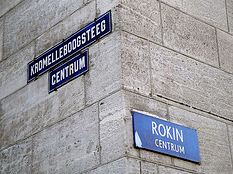
Kromme Elleboogsteeg no longer exists as it used to. The Peek and Cloppenburg Department Store (with Madame Tussauds wax museum above) was constructed in 1917 on the place where the entrance to Kromme Elleboogsteeg on Dam Square used to be.
However a small section of the former Kromme Elleboogsteeg remains, a little alleyway off Rokin street which is today called “Kromelleboogsteeg” (located right behind Peek and Cloppenburg in Dam Square).
Before Peek & Cloppenburg was constructed, t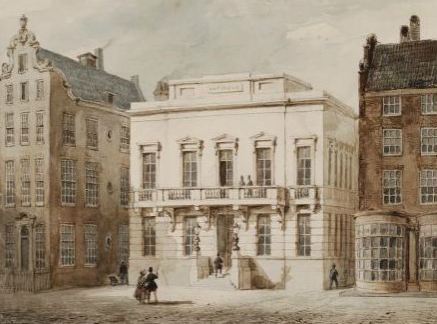 he white Friendship Society (Sociëteit De Vriendschap) building sat to the right of Kromme Elleboogsteeg’s entrance (in Dam Square), built in 1838. Later, the Grand Café-Restaurant Mulder was briefly in this spot (for about a year), then later, that building was replaced with Zeemanshoop (seaman shop) (from 1864-1914). To the left of Kromme Elleboogsteeg’s entance were some old houses that had a distinctive curved rooftop. Beside those houses, the Rijnstroom (PGC Hajenius’s cigar shop) was located from 1869 (that shop was later relocated to Rokin).
he white Friendship Society (Sociëteit De Vriendschap) building sat to the right of Kromme Elleboogsteeg’s entrance (in Dam Square), built in 1838. Later, the Grand Café-Restaurant Mulder was briefly in this spot (for about a year), then later, that building was replaced with Zeemanshoop (seaman shop) (from 1864-1914). To the left of Kromme Elleboogsteeg’s entance were some old houses that had a distinctive curved rooftop. Beside those houses, the Rijnstroom (PGC Hajenius’s cigar shop) was located from 1869 (that shop was later relocated to Rokin).
The building of Peek & Clophenburg: The P & C company purchased 13 plots at the Dam, the Rokin, Kalverstraat and Kromelleboogsteeg. They were then given permission to demolish the entire south side of the dam between Kalvers
traat and Rokin, so that they could construct their building there. As part of this, a picturesque row of old houses were demolished to make way for the big new building (which was constructed in 1917). As a consolation for this loss, 14 named bricks were built into the wall of the Peek & Clopenburg building in remembrance of the houses that once stood there.

